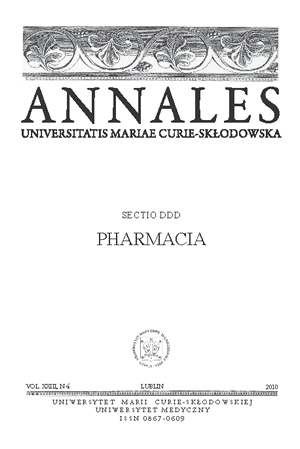Evaluation of the level of chromium and nickel in selected dietary supplements (containing antioxidant compounds) available in Poland
Keywords:
dietary supplements, chromium, nickel, flame atomic absorption spectrometer (FAAS)Abstract
Among the dietary supplements whose assortment is still increasing, preparations containing anti-oxidants constitute an important group protecting the human organism against free radicals. As there is a scarcity of studies concerning the content of the microelements essential for human the body in dietary supplements, contents of chromium and nickel in preparations applied in the prevention of illnesses and in the therapy of the sight organ were studied and as well as in the therapy of the sight organ – Aronia z luteiną (Chokeberry with luteine), Bilberin, Maxi Vision, Naturapia wzrok, Oculobon, Pro-wzrok, Vitalux) and those containing garlic in their composition – Aktiv Kapseln, Aliovital, Alitol, Bio-czosnek (Bio-garlic), Czosnek forte (Garlic forte), Czosnek z pietruszką (Garlic with parsley ), Garlicin, Tabletki z czosnkiem (Tablets with garlic). Samples (4–5 gram) were mineralized “dry” in temperature of 450˚C. The amounts of the studied elements were determined in of the Pye Unicam SP 192 atomic absorption spectrometer: chromium directly from the mineralisate, and nickel after the extraction up to the organic phase (MIBK). Contents of chromium ranged, on average from 0.04 µg/g to 6.85 µg/g, and those of nickel from 0.03 µg/g to 1.98 µg/g. The indicated amounts of chromium and nickel in inspected dietary supplements were diversified and they depended on the composition of the preparation. Contents of these elements taken with the maximum daily dose declared by the producer can be regarded safe for the human body and they supplement the daily demand of the organism for these microelements in the supplementation process.
References
1. Anke M.: The biological importantance of nickel In the food chain. Fresenius J. Anal. Chem., 352, 92, 1995.
2. Błoniarz J., Zaręba S.: Selected microelements (Cr, Zn, Cu, Mn, Fe, Ni) in slimming preparations. Roczn. PZH, 58, 165, 2007.
3. Błoniarz J.: Study of Some Microelements Level in Selected Preparations Containing Phytoestrogens. Polish J. Environ. Stud., 17 (1B), 18, 2008.
4. Cornelli U.: Antioxidant use in nutraceutical. Clin. Dermatol., 27, 175, 2009.
5. Dybczyński R. et al.: Preparation and Certification of the Polish Reference Material „Mixed Polish Herbs” (INST-MPH-2) for inorganic Trace Analysis, Raporty IChTJ, Seria A nr 4/2002, Institute of Nuclear Chemistry and Technology, Warszawa 2002.
6. Elless M.P. et al.: Plants as a natural source of concentrated mineral nutritional supplements. Food Chem., 71, 181, 2000.
7. European Commission Health and Consumer Protection Directorate-General. Scientific Committee on Food. Opinion of the Scientific Committee on Food on the Torelable Upper Intake Level of Trivalent Chromium. Brussels 2003
8. Food and Nutrition Board. Institute of Medicine. Dietary References Intakes for Vitamin A, Vitamin K, Arsenic, Boron, Chromium, Copper, Iodine, Iron, Manganese, Nickel, Silicon, Vanadium, and Zinc. National Academy Press, Washington, DC 2001.
9. Leśniewicz A., Jaworska K., Żyrnicki W.: Macro- and micro-nutrients and their bioavailability in polish herbal medicaments. Food Chem., 99, 670, 2006.
10. Mechanick J.I. et al.: American Association of Clinical Endocrinologists Medical Guidelines for the clinical use of dietary supplements and nutraceuticals. AACE Nutrition Guidelines Task Force. Endocrine Practice, 9, 417, 2003.
11. Pinta M.: Absorpcyjna spektrometria atomowa. Zastosowanie w analizie chemicznej. PWN, Warszawa 1977
12. Sapek A.: Oznaczanie ołowiu, niklu i kobaltu w wyciągu glebowym metodą ASA, po zagęszczeniu do fazy organicznej. Chem. Anal., 19, 687, 1974.
13. Shikany J.M. et al.: Antioxidant suplement use In Women's Health Initiative participants. Preventive Medicine, 36, 379, 2003.
14. Stearns D.M. et al.: Chromium (III) tris (picolinate) is mutagenie AT the hypoxanthine (guanine) phosphoribosyltransferase locus in Chinese hamster ovary cells. Mutatio Research, 513, 135, 2002.
15. Vincent J.B.: The Biochemistry of Chromium. J. Nutr., 130, 715, 2000.
16. Vincent J.B.: The bioinorganic chemistry of chromium (III). Polyhedron, 20, 1, 2001.
Downloads
Published
Issue
Section
License
Copyright (c) 2010 Authors

This work is licensed under a Creative Commons Attribution-NonCommercial-NoDerivatives 3.0 Unported License.


